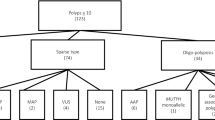Abstract
De novo mutations in the adenomatous polyposis coli (APC) gene are estimated to constitute approximately 25% of familial adenomatous polyposis (FAP) cases. A small percentage of these arise in the mosaic form, affecting only a subset of cells in the affected individual. A family is described here whereby an unaffected mother with no detectible mutation in APC, transmitted the identical APC c.4729G>T (p.Glu1577X) mutation to two children. A third child, with the same APC allelic haplotype received a normal APC allele, suggesting that the mutation originated in the gonadal tissues of the mother. These results underscore the utility of mutation-specific genetic testing for the parents and siblings of a proband of an adult-onset disease, even if the proband appears to have a de novo mutation. Parents who test negative for the mutation should be counseled about the possibility of having another affected child due to gonadal mosaicism.



Similar content being viewed by others
Abbreviations
- Familial adenomatous polyposis:
-
FAP
- Adenomatous polyposis coli:
-
APC
References
Petersen GM, Slack J, Nakamura Y (1991) Screening guidelines and premorbid diagnosis of familial adenomatous polyposis using linkage. Gastroenterology 100(6):1658–1664 Jun
Burt RW (2003) Gastric fundic gland polyps. Gastroenterology 125(5):1462–1469 Nov
Kadmon M, Tandara A, Herfarth C (2001) Duodenal adenomatosis in familial adenomatous polyposis coli. A review of the literature and results from the Heidelberg Polyposis Register. Int J Colorectal Dis 16(2):63–75 Apr
Cetta F, Curia MC, Montalto G et al (2001) Thyroid carcinoma usually occurs in patients with familial adenomatous polyposis in the absence of biallelic inactivation of the adenomatous polyposis coli gene. J Clin Endocrinol Metab 86(1):427–432 Jan
Cetta F, Montalto G, Gori M, Curia MC, Cama A, Olschwang S (2000) Germline mutations of the APC gene in patients with familial adenomatous polyposis-associated thyroid carcinoma: results from a European cooperative study. Journal of Clin Endocrinol Metabolism 85(1):286–292 Jan
Wallace MH, Phillips RK (1998) Upper gastrointestinal disease in patients with familial adenomatous polyposis. Br J Surg 85(6):742–750 Jun
Rustin RB, Jagelman DG, McGannon E, Fazio VW, Lavery IC, Weakley FL (1990) Spontaneous mutation in familial adenomatous polyposis. Dis Colon Rectum 33(1):52–55 Jan
Davidson S, Leshanski L, Rennert G, Eidelman S, Amikam D (2002) Maternal mosaicism for a second mutational event—a novel deletion—in a familial adenomatous polyposis family harboring a new germ-line mutation in the alternatively spliced-exon 9 region of APC. Hum Mutat 19(1):83–84 Jan
Niu DM, Huang JY, Li HY et al (2006) Paternal gonadal mosaicism of NIPBL mutation in a father of siblings with Cornelia de Lange syndrome. Prenat Diagn 26(11):1054–1057 Nov
Depienne C, Arzimanoglou A, Trouillard O et al (2006) Parental mosaicism can cause recurrent transmission of SCN1A mutations associated with severe myoclonic epilepsy of infancy. Hum Mutat 27(4):389 Apr
Gennaro E, Santorelli FM, Bertini E et al (2006) Somatic and germline mosaicisms in severe myoclonic epilepsy of infancy. Biochem Biophys Res Commun 341(2):489–493 Mar 10
Byers PH, Tsipouras P, Bonadio JF, Starman BJ, Schwartz RC (1988) Perinatal lethal osteogenesis imperfecta (OI type II): a biochemically heterogeneous disorder usually due to new mutations in the genes for type I collagen. Am J Hum Genet 42(2):237–248 Feb
Cohen-Solal L, Bonaventure J, Maroteaux P (1991) Dominant mutations in familial lethal and severe osteogenesis imperfecta. Hum Genet 87(3):297–301 Jul
Grange DK, Balfour IC, Chen SC, Wood EG (1998) Familial syndrome of progressive arterial occlusive disease consistent with fibromuscular dysplasia, hypertension, congenital cardiac defects, bone fragility, brachysyndactyly, and learning disabilities. Am J Med Genet 75(5):469–480 Feb 17
Lund AM, Nicholls AC, Schwartz M, Skovby F (1997) Parental mosaicism and autosomal dominant mutations causing structural abnormalities of collagen I are frequent in families with osteogenesis imperfecta type III/IV. Acta Paediatr 86(7):711–718 Jul
Raghunath M, Mackay K, Dalgleish R, Steinmann B (1995) Genetic counselling on brittle grounds: recurring osteogenesis imperfecta due to parental mosaicism for a dominant mutation. Eur J Pediatr 154(2):123–129 Feb
Somprasit C, Aguinaga M, Cisneros PL et al (2004) Paternal gonadal mosaicism detected in a couple with recurrent abortions undergoing PGD: FISH analysis of sperm nuclei proves valuable. Reprod Biomed Online 9(2):225–230 Aug
den Dunnen JT, Antonarakis SE (2000) Mutation nomenclature extensions and suggestions to describe complex mutations: a discussion. Hum Mutat 15(1):7–12
Farrington SM, Dunlop MG (1999) Mosaicism and sporadic familial adenomatous polyposis. Am J Hum Genet 64(2):653–658 Feb
Aretz S, Stienen D, Friedrichs N et al (2007) Somatic APC mosaicism: a frequent cause of familial adenomatous polyposis (FAP). Hum Mutat 28(10):985–992
Hes FJ, Nielsen M, Bik EC, et al (2007) Somatic APC Mosaicism: An Underestimated Cause Of Polyposis Coli. Gut (in press)
Bisgaard ML, Fenger K, Bulow S, Niebuhr E, Mohr J (1994) Familial adenomatous polyposis (FAP): frequency, penetrance, and mutation rate. Hum Mutat 3(2):121–125
Aretz S, Uhlhaas S, Caspari R et al (2004) Frequency and parental origin of de novo APC mutations in familial adenomatous polyposis. Eur J Hum Genet 12(1):52–58 Jan
Acknowledgements
We greatly appreciate the diagnostic skills and far-reaching intuition of Dr. Mark Peterson D.D.S, who first recognized osteomas and cysts in the family and referred them for further medical attention. We also acknowledge Jared Cox for family history data evaluation and pedigree construction. This research is supported by NCI grants P01-CA073992 (RWB) and R01-CA040641(RWB).
Author information
Authors and Affiliations
Corresponding author
Rights and permissions
About this article
Cite this article
Schwab, A.L., Tuohy, T.M.F., Condie, M. et al. Gonadal mosaicism and familial adenomatous polyposis. Familial Cancer 7, 173–177 (2008). https://doi.org/10.1007/s10689-007-9169-1
Received:
Accepted:
Published:
Issue Date:
DOI: https://doi.org/10.1007/s10689-007-9169-1




